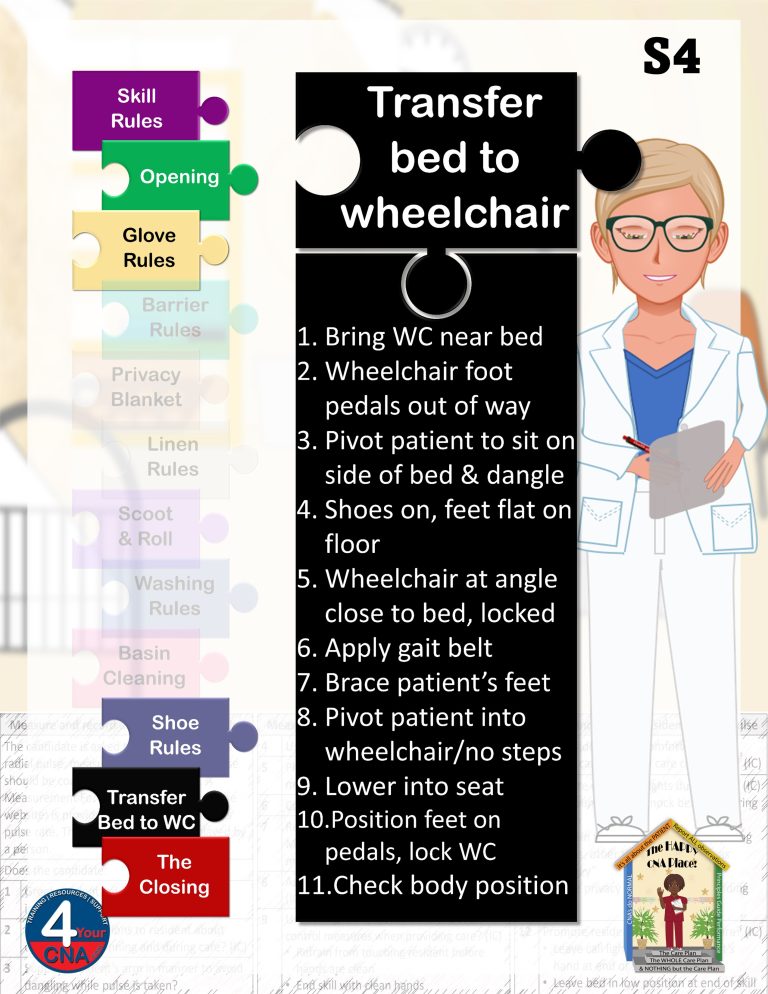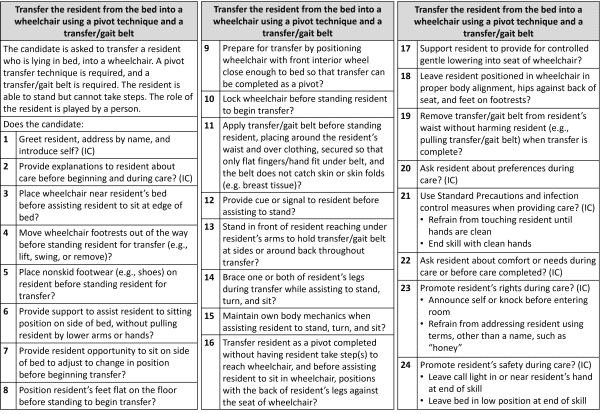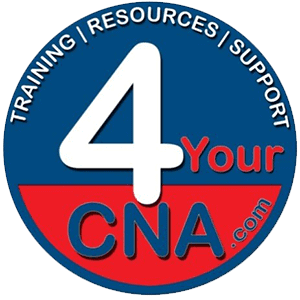Transfer the Resident from Bed to Wheelchair
Ambulating a patient using a gait belt is a fundamental skill for CNAs and other healthcare providers. It ensures safe and effective mobility support, helping prevent falls and injuries. Many Residents—especially those who are weak, elderly, or recovering from surgery—rely on assistance during walking. Correct use of a gait belt not only promotes independence but also reduces caregiver strain and enhances overall Resident confidence. Mastering this skill is critical for maintaining safety standards and boosting mobility outcomes in medical settings.
You will need the following when Transferring a Resident from a Bed to a Wheelchair:
- Wheelchair
- Gait Belt
- Non-Skid Footwear (Resident’s Own)
1. Preparation & Hand Hygiene
- Read and follow the Care Plan, the whole Care Plan, and nothing but the Care Plan.
- Knock and announce yourself before entering.
- Greet the Resident by name and introduce yourself.
- Explain the task to the Resident and ensure their comfort and consent.
- Close the Privacy Curtain
- Wash your hands thoroughly before beginning.
- Assess Glove Rules (Are Gloves required for this Resident?)
- Gather your Supplies.
2. Positioning the Resident
- Ensure Resident is lying flat, with arms crossed across their chest, near the edge of the Bed closest to you.
- Place one arm under Resident’s shoulders.
- Place other arm over Resident’s leg’s, grasping under the knees.
- Countdown with Resident prior to rotating them into a sitting position.
- Ensure Resident comfort, stability, and that they are sitting up straight on edge of the bed.
- Assist Resident with putting on their Skid-resistant shoes.
- Ensure shoes are comfortable and Resident’s feet are flat on the floor.
3. Applying the Gait Belt
- Extend Gait belt, wrapping it around Residents waist.
- Asking Resident to raise their arms can assist in placement of the Gait Belt.
- Secure the Gait belt around Resident, passing the tail end of the belt through the buckle to secure the Gait Belt.
- Ensure Gait Belt has space for 4 fingers to fit snugly between it and the Resident.
- Tuck the tail end of Gait Belt behind the Gait Belt to secure it.
4. Positioning the Wheelchair
- Verify Wheelchair feet are in the “stowed” position. (Feet rest are on sides of wheelchair, not in front of the chair).
- Verify area is clear or obstructions or obstacles.
- Place the Wheelchair next to the bed at a slight angle, almost touching the Resident.
- Lock Wheelchair Wheels.
- Verify Wheelchair position.
- Position Resident’s feet together, flat on the floor.
5. Proper Body Mechanics & Standing the Resident
- Stand in front of and to the side of the Resident
- Place one foot sideways in front of Resident’s Feet, this prevents their feet from sliding out.
- Place the other foot to the Resident’s Side, ensuring Stability as you lift the Resident.
- Ask Resident to place their hands on your shoulders.
- Reaching around Resident, grab Gait Belt with both hands behind Resident’s back.
- Count down out loud with Resident before standing.
- Bend and lift with your knees.
- Pivot Resident in front of Wheelchair.
7. Seating the Resident
- Ask Resident to notify you once they feel the Wheelchair on the back of their legs to ensure safety as they sit.
- Assist Resident the same way you assisted in standing.
- Ask Resident to place Hands on your shoulders
- Stand in front of and to the side of the Resident
- Countdown for the Resident to sit down, supporting Resident using the Gait Belt as they sit.
- Remove Gait Belt
- Be careful not to drag Gait Belt aross Resident’s skin.
- Unlock Wheelchair
- Turn Resident so they face away from the Wall.
- Lock the Wheelchair.
- Turn footrests to front position and ensure they are locked.
- Place Resident’s feet on footrests.
8. Address Resident Comfort & Closing
- Ensure Resident is comfortable.
- Ensure Resident is sitting properly in the chair.
- Feet flat on the Wheelchair footrests
- Hips against the back of the chair
- Resident sitting up straight
- Ask about Resident needs and preferences.
- Provide Resident with Call light.
- Open Privacy curtain and ensure bed is in lowest position.
- Thoroughly wash your hands.
- Record additional relevant observations.
- Thoroughly wash your hands.
- Think about the Steps of your Skill. Make any corrections. Tell the evaluator your Skills is complete.
- Not reading and following the Care Plan, the whole Care Plan, and nothing but the Care Plan.
- Not Providing Resident with Call Light.
- Not ensuring bed is left in lowest position.
- Not ensuring Proper Body Mechanics when positioning Resident.
- Not Properly securing Gait Belt on Resident.
- Dragging Gait Belt across Resident’s skin.
- Not properly holding Gait Belt when ambulating Resident.
- Not communicating when you are standing/sitting to Resident
- Not asking Resident about feelings or dizziness throughout.
- Not placing Resident’s Hands on shoulders when standing/sitting Resident.
- Taking any steps during this Skill
- Not ensuring an obstacle free environment
- Positioning Wheelchair too far/walking Resident
- Maintaining proper body mechanics throughout skill.
- Not locking Wheelchair at appropriate times.
- Leaving Resident facing a wall or in an uncomfortable position.


Join our FREE Classroom Livestream on Mondays & Wednesdays from 9am – 1pm (ET) on FLCNATraining.com!

